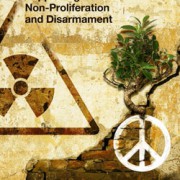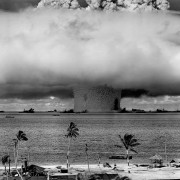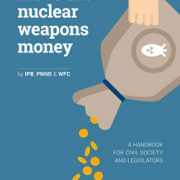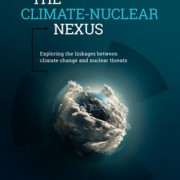Climate-Nuclear Nexus
“The threats to our planet – of climate change, poverty and war – can only be overcome by nations and the global community working in cooperation – something not possible while nations maintain large and expensive militaries and threaten to destroy each other.” – PNND Co-President’s statement on International Women’s Day for Disarmament, May 24, 2008
The second project is an extensive study of the linkages between climate change and nuclear security conducted for the World Future Council by Disarmament Working Group member Prof. Dr. Jürgen Scheffran of the University of Hamburg. Prof. Dr. Scheffran’s Report Climate Change, Nuclear Risks and Nuclear Disarmament: From Security Threats to Sustainable Peace lays bare the important connections between the two perils, reframes the debate on both issues and offers a comprehensive approach to move from living with these security threats to building sustainable peace. You can download the Report here.
The climate-nuclear nexus manifests itself in a number of ways.
Natural disasters and climate change-induced extreme weather events can have grave implications for nuclear security and safety
The nuclear disaster in Fukushima in March 2011 has drawn attention to the possible effects of extreme weather events, environmental degradation and seismic activity on nuclear security and safety. A number of other recent natural disasters have demonstrated how extreme weather events and environmental degradation can directly cause severe threats for nuclear safety and security.
- The wildfires that spread through Russia in the summer of 2010 posed a severe nuclear risk to the country when they were on their way to engulf key nuclear sites. In addition, there was widespread concern that radionuclides from land contaminated by the 1986 Chernobyl nuclear disaster could rise together with combustion particles, resulting in a new pollution zone. Luckily, the authorities managed to contain the fires in time.
- In Pakistan, the climate-nuclear nexus becomes particularly apparent. Past natural disasters have heightened anxieties about the safety and security of Pakistan’s nuclear sites and military installations. So far, nuclear sites in the extreme weather-prone country have remained safe, yet concern exists about the possible damage from future natural disasters, as well as the security of Pakistan’s nuclear arsenal and materials during such events.
- The events in Japan earlier this year have demonstrated the potential catastrophic consequences of natural disasters for nuclear security. The 9.0-magnitude earthquake and subsequent tsunami that hit the country on 11 March 2011 caused major damage to the Fukushima Daiichi nuclear power plant, disabling the reactor cooling systems and triggering a widespread evacuation surrounding the plant. The nuclear crisis is still unfolding and it will be decades before a comprehensive impact assessment of the disaster can be made.
- In the UK, leading geologist Prof. Rob Duck of Dundee University has warned that if climate change continues it may lead to the erosion of Britain’s coast and may even cause tsunamis. This in turn will have critical implications for the safety of Britain’s nuclear power stations, all but one of which lie on the coast.
The climatic and ecological consequences of nuclear war
Recent research has revealed that even a limited regional nuclear exchange would eject so much debris into the atmosphere that it could cool down the planet to temperatures not felt since the ice ages (“nuclear winter”) and significantly disrupt the global climate for years to come. Huge fires caused by nuclear explosions, in particular from burning cities, would lift massive amounts of dark smoke and aerosol particles into the upper parts of the atmosphere where the absorption of sunlight would further heat the smoke and lift it into the stratosphere. Here the smoke could persist for years and block out much of the sun’s light from reaching the earth’s surface, causing surface temperatures to drop drastically. This would have disastrous implications for agriculture, and threaten the food supply for most of the planet. It has been estimated that as a result up to one billion people could die from starvation.
Conflicts due to climate change can trigger the use of nuclear weapons
Recently, attention has also been drawn to the severe security risks of global warming. The fear concentrates on how large-scale cascading events in the climate system could lead to international instability. Conflicts due to climate change can trigger the use of nuclear weapons.
UN Secretary-General Ban Ki-moon has warned that climate change may pose as much of a danger to the world as war. In April 2007, the UN Security Council held its first debate on climate change indicating that global warming has elevated to the top of the international security agenda, rivalling the threat of war. In a 2008 report, the European Commission noted that “[c]limate change is best viewed as a threat multiplier which exacerbates existing trends, tensions and instability. The core challenge is that climate change threatens to overburden states and regions which are already fragile and conflict prone.”
Nuclear weapons represent a particularly worrying element in this volatile equation. International destabilization resulting from climate change could provoke conflicts, which, in turn, could enhance the chance of a nuclear weapon being used, could create more fertile breeding grounds of terrorism, including the nuclear kind, and could feed the ambitions among some states to acquire nuclear arms.
If climate change is a threat multiplier which exacerbates existing trends, tensions and instability, then nuclear weapons are capable of raising the stakes exponentially.
Nuclear energy is no solution to fossil energy dependence and global warming
Nuclear power is fraught with security risks and a variety of other problems. Firstly, radioactive materials are released and accumulated at each stage of the nuclear fuel cycle, while errors and accidents during the generation process further contribute to the threat of radioactive contamination.
Secondly, nuclear power is inextricably linked to nuclear weapons development. So far, about one-third of the countries using nuclear power have built nuclear weapons. At various stages of the nuclear fuel chain, transitions to nuclear weapons technology are possible, contributing to the danger of their worldwide proliferation. A serious problem is the civil-military ambivalence of nuclear technologies and facilities involved in the production and processing of weapons-grade materials. These include uranium enrichment, fuel production and reprocessing of spent nuclear fuel. Around 20 countries already have access to such technologies. This trend would increase with a further global expansion of nuclear energy.
The global inventory of highly enriched uranium totals around 1600 tons, while the global stockpile of separated plutonium is about 500 tons, divided almost equally between civilian and military stocks. One hundred tons of plutonium is theoretically sufficient for up to 20,000 nuclear warheads. With increasing civilian use, the amount of plutonium also tends to increase. The difficulty in distinguishing between civilian and military nuclear ambitions remains a source for discrimination, threat, mistrust and fear in international relations.
Thirdly, even a drastic increase in nuclear energy could not compensate for the current growth in energy consumption; it would come too late for preventing climate change and lead to an enormous increase in plutonium stocks, with all its aforementioned problems.
Fourthly, although nuclear power has been heavily subsidised by governments and external costs are still not internalised into its market price, nuclear energy is not commercially competitive compared to advanced renewable energies that receive similar financial support. In a comprehensive environmental and economic assessment, including external costs from waste disposal, uranium mining, fuel processing and radioactive emissions during normal operations, most renewable energy sources look better than nuclear energy.
Finally, nuclear waste disposal (whether from nuclear power production, nuclear weapons programs or nuclear disarmament) will remain a problem for thousands of years, and many future generations will have to bear this load without having the short-term “benefit” of the current generation. To decay half of the amount of plutonium 239, which is the primary fissile isotope used for the production of nuclear weapons, it takes around 24000 years or 1000 human generations, much longer than the known history of homo sapiens. After decades of nuclear energy production, the pile of nuclear waste is still growing, even though worldwide not a single site for final disposal of spent fuels is operating and temporary storage is continuously being extended. It is uncertain whether and when a responsible solution to the long-term disposal of radioactive waste can be found.










